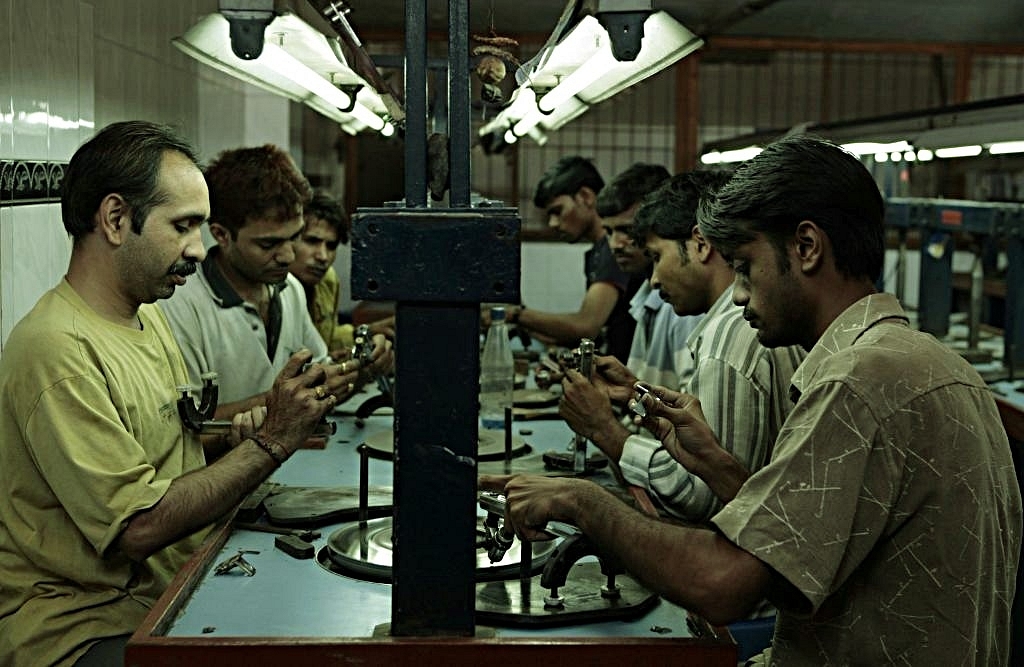Business
With Growth-Jobs Link Broken, The Only Antidote To ‘Jobless Growth’ Is More Labour Reforms
- India’s jobs problem cannot be dealt with purely by focusing on growth. The country needs to focus on reforms, especially in labour-intensive industries.

Workers polish diamonds at a factory in Dahisar near Mumbai. (Satish Bate/Hindustan Times via Getty Images)
Jobs ought to be a prime focus for any Indian government, but a major paradigm shift has taken place which has broken the old link between growth and jobs. In an era of abundant capital, where productivity and output can be raised without adding much labour, every ounce of gross domestic product (GDP) growth today gives a lower bounce in terms of new jobs.
The World Bank’s latest South Asia Economic Focus (Spring) 2018 (download the full report from here) underlines this point as never before. While debunking the headline claim that India, and other South Asian countries, are seeing “jobless growth”, the report emphasises that every percentage point increase in GDP has a lower impact on jobs than before. For South Asia as a whole, the employment elasticity of growth is 0.19 per cent – which means every 1 per cent growth in GDP gets you 0.19 per cent growth in jobs. Put more simply, if India grows at 7.5 per cent, jobs will grow by 1.4 per cent to 1.5 per cent.
The good news is this: India has not seen jobless growth, and the World Bank report says every 1 per cent growth in GDP creates around 750,000 jobs. At 7.5 per cent GDP growth, which could be our rate in 2018-19, we will be creating about 5.6 million jobs.
The bad news is that given the steep rise in our working age population, we need to create 8.1 million jobs annually. The gap between jobs created and jobs required is already 2.5 million. To absorb all the numbers in jobs, India’s growth rate at the current employment rate of around 50 per cent would need to rise to around 11 per cent – something we have never achieved before. (The employment rate is the number of people working as a proportion of the 15+ working age population.)
A second bit of bad news is that the jobs created are not necessarily jobs in any conventional sense of the term. Says the report: “regular wage employment, regardless of whether it is formal or informal, is uncommon in South Asia. Regular wage employment does not necessarily mean a nine-to-five job, with a written contract and benefits attached. It simply means that there is a stable and predictable employment-employee relationship, and that the worker can expect to still have the job the following month. But even with this stripped-down definition, across South Asia only around one-tenth of the working-age population has a regular wage job”.
The key issue flagged by the report is that if we want to actually raise the employment rate to levels achieved by some of the south-east Asian countries at this stage in the development cycle, India will need 18 per cent annual GDP growth – a near impossibility. Raising the employment rate from current low levels means getting more people, especially women, to take up wage-paying jobs.
The simple takeout from the World Bank report is this: India’s jobs problem cannot be dealt with purely by focusing on growth. It needs to focus on reforms, especially in labour-intensive industries, so that the tendency to replace labour with capital ends.
The National Democratic Alliance government has been moving in that direction, by allowing companies to offer more fixed-term contracts for workers. The proposal, originally meant for the textile industry, has recently been extended to many more industries. Under the Industrial Employment (Standing Order) Act, 2016, workers in fixed-term contracts can get all the benefits of normal employment, including wages and social security comparable to regular workers, but non-renewal of contracts at the end of its tenure means termination. The contract can be terminated with two weeks’ notice once a worker has completed three months of service.
This reform is in the right direction, but clearly more reforms are critical. No government in future can act on the presumption that growth is the solution to jobs; growth is a necessary condition for job creation, but not a sufficient one in an era of abundant capital.
Support Swarajya's 50 Ground Reports Project & Sponsor A Story
Every general election Swarajya does a 50 ground reports project.
Aimed only at serious readers and those who appreciate the nuances of political undercurrents, the project provides a sense of India's electoral landscape. As you know, these reports are produced after considerable investment of travel, time and effort on the ground.
This time too we've kicked off the project in style and have covered over 30 constituencies already. If you're someone who appreciates such work and have enjoyed our coverage please consider sponsoring a ground report for just Rs 2999 to Rs 19,999 - it goes a long way in helping us produce more quality reportage.
You can also back this project by becoming a subscriber for as little as Rs 999 - so do click on this links and choose a plan that suits you and back us.
Click below to contribute.
Latest